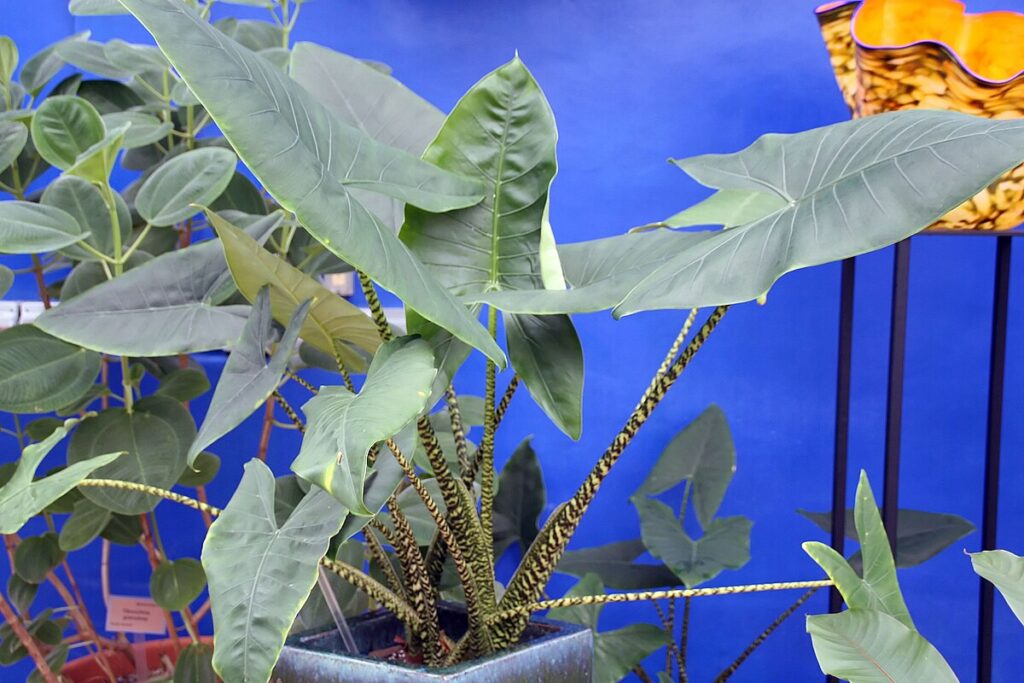Indoor gardening continues to surge in popularity as plant lovers seek striking, rare species to elevate their living spaces. Two tropical showstoppers that have captivated collectors and enthusiasts alike are the Alocasia Chantrieri and the Alocasia Zebrina. Known for their exotic foliage and dramatic presence, these plants bring a sense of the rainforest right into your home. But to thrive, they need specific care that aligns with their natural environments.
In this blog, we’ll delve into what makes each of these Alocasia species unique and provide practical care tips to help them flourish year-round.
Understanding the Unique Beauty of Alocasia Chantrieri and Alocasia Zebrina
The Alocasia Chantrieri is often referred to as the “Mirror Plant” due to its dark green, metallic-looking leaves with deeply veined textures and a contrasting burgundy underside. Originating from Southeast Asia, this plant is admired for its dramatic leaf shape and sheen, making it a standout piece in any indoor garden.
On the other hand, the Alocasia Zebrina is instantly recognizable by its arrowhead-shaped leaves and distinctively patterned stems that resemble zebra stripes—hence the name. Native to the Philippines, this species has gained popularity for its architectural appearance and bold design statement.
Despite their visual differences, both plants share similar tropical origins, which dictate their growing conditions and care needs.
Ideal Lighting Conditions
Both Alocasia Chantrieri and Alocasia Zebrina prefer bright, indirect light. These are not plants that do well in full sun exposure, as their leaves can scorch easily. Position them near a north or east-facing window, or filter strong light with sheer curtains. If your home doesn’t offer much natural light, consider using a grow light to supplement their needs, especially during the winter months.
Avoid placing them in low-light areas, as this can lead to leggy growth and poor leaf development.
Watering Wisely
Watering is a critical factor when caring for these tropical beauties. Alocasias prefer their soil to be consistently moist but never soggy. Allow the top 1-2 inches of soil to dry out between watering sessions. Overwatering can quickly lead to root rot, one of the most common issues with these plants.
It’s also beneficial to use room-temperature, distilled, or rainwater. Both Alocasia Chantrieri and Alocasia Zebrina can be sensitive to the chemicals in tap water, such as chlorine and fluoride.
The Right Soil and Potting Mix
A well-draining, airy soil mix is essential for healthy root development. Use a potting mix that contains components like perlite, orchid bark, and peat moss. This ensures proper aeration and drainage while retaining enough moisture to mimic the plant’s natural habitat.
Repotting should be done every 1-2 years or when the roots become cramped. Spring is the ideal time to repot, giving the plant a chance to adjust and thrive during the growing season.
Humidity and Temperature Needs
Tropical by nature, Alocasia Chantrieri and Alocasia Zebrina require a humid environment to stay healthy. Aim for a humidity level above 60%, which can be achieved using a humidifier, placing the plant on a pebble tray filled with water, or grouping it with other tropical plants.
As for temperature, both species prefer a range between 65°F and 80°F (18°C to 27°C). Avoid placing them near drafts, heaters, or air conditioning vents, as sudden temperature changes can stress the plant and cause leaf drop.
Fertilizing for Growth
During the growing season (spring through early fall), feed your Alocasias with a balanced, water-soluble fertilizer every 2-4 weeks. Avoid over-fertilizing, which can lead to salt buildup and damage the roots. Reduce feeding during the dormant winter months, when the plant’s growth naturally slows down.
Dealing with Common Issues
Both Alocasia Chantrieri and Alocasia Zebrina are prone to pests such as spider mites, aphids, and mealybugs. Regularly inspect the undersides of leaves and stems, and treat infestations with neem oil or insecticidal soap.
Another common issue is leaf yellowing, often caused by overwatering, poor drainage, or inadequate light. Adjust your care routine accordingly and consider improving airflow around the plant to reduce the risk of fungal infections.
Propagation Tips
Propagation can be done through division during repotting. Carefully separate the plant’s rhizomes, ensuring each section has a healthy root system and a few leaves. Plant each division in fresh potting mix and provide consistent warmth and humidity to encourage new growth.
Final Thoughts
Both Alocasia Chantrieri and Alocasia Zebrina are excellent choices for plant lovers who appreciate bold, sculptural foliage and enjoy the challenge of caring for tropical species. While they may require more attention than the average houseplant, the reward is a vibrant and visually striking addition to your indoor jungle.
By replicating their natural environment and following the care tips outlined above, you’ll be well on your way to nurturing thriving tropical beauties that will be the envy of every houseplant enthusiast.

